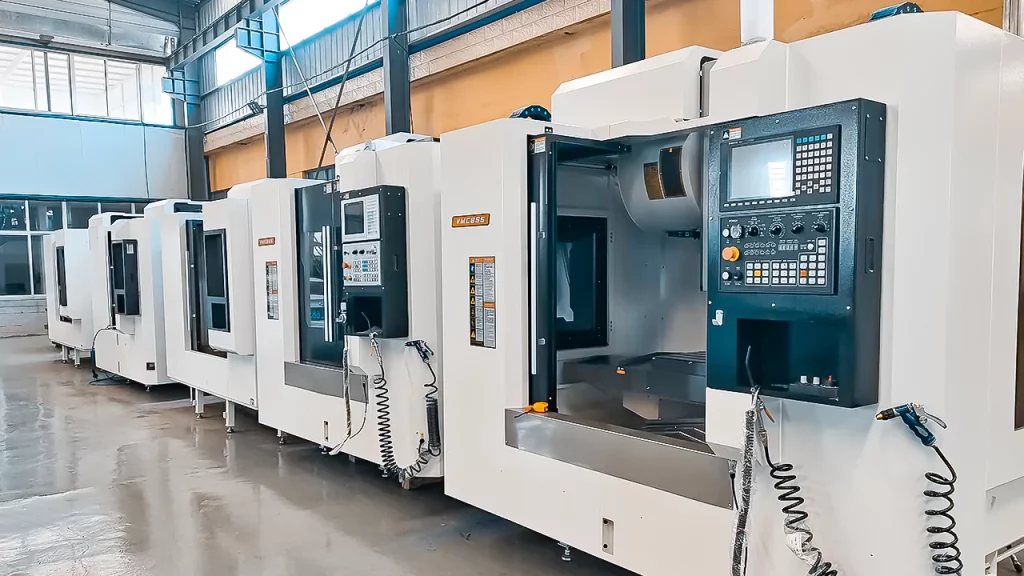CNC Machine Capabilities

CNC machines perform high-precision, automated manufacturing operations across metals, plastics, and composites.
Their core capabilities include micrometer-level accuracy, advanced software integration, robotic handling, real-time inspection, and scalable production modes.
What Are the Precision and Tolerance Levels of CNC Machines?
CNC machines operate with dimensional tolerances as tight as ±0.001 mm, depending on machine type and setup.
Common tolerance standards:
| CNC Machine Type | Standard Tolerance | High-Precision Capability |
|---|---|---|
| CNC Milling | ±0.01 mm | ±0.005 mm |
| CNC Turning | ±0.01 mm | ±0.002 mm |
| Swiss-type CNC | ±0.005 mm | ±0.001 mm |
| 5-Axis CNC | ±0.008 mm | ±0.003 mm |
Precision determines fit, finish, and functional reliability—especially critical in aerospace, medical, and robotics applications.
How Does CAD/CAM Integration Enhance CNC Machining?
CAD/CAM integration automates the conversion of design files into machine-readable instructions.
CAD defines geometry; CAM generates toolpaths and G-code, minimizing manual input and errors.
Benefits of integration:
-
Seamless workflow from design to production
-
Simulation of toolpaths before machining
-
Compatibility with multi-axis setups
-
Reduction in programming time
Popular platforms: Fusion 360, Mastercam, SolidWorks CAM, Siemens NX
Use case: Complex aerospace brackets are simulated, programmed, and milled directly from CAD with minimal human intervention.
How Are Automation and Robotics Integrated into CNC Machining?
Automation enhances CNC machining with unattended operations, part handling, and tool management.
Forms of CNC automation:
-
Robotic arms: Load/unload raw and finished parts
-
Pallet changers: Enable high-volume, multi-shift production
-
Automatic tool changers (ATC): Reduce cycle time
-
Sensor-driven feedback loops: Maintain tool condition and part consistency
Industries using robotic CNC: Automotive, medical devices, and electronics manufacturing
Result: Higher throughput, fewer human errors, and 24/7 operational capability
What Are Real-Time Quality Control Systems in CNC?
Real-time quality control uses sensors, probes, and cameras to measure part features during machining.
It reduces defects, supports tight tolerances, and enables adaptive control.
Key technologies:
-
Touch probes: Measure dimensions mid-process
-
Laser scanners: Detect surface irregularities
-
Machine vision systems: Inspect geometry and orientation
-
Closed-loop systems: Auto-correct toolpaths in real time
Example:
Medical part production uses in-cycle probing to validate ±0.002 mm tolerances without manual inspection.
What Role Do Tooling and Fixtures Play in CNC Capability?
Tooling enables cutting; fixtures secure the part during machining.
Their quality directly affects dimensional accuracy, repeatability, and setup efficiency.
Tooling types:
-
Solid carbide end mills, drills, taps
-
Indexable cutters for high-volume runs
-
Coated tools (TiN, AlTiN) for durability
Fixture types:
-
Modular vises and clamps
-
Vacuum and magnetic fixtures
-
Custom jigs for irregular shapes
Optimized fixturing reduces vibration, improves tool life, and ensures repeatability across batches.
How Does CNC Handle Batch vs. Continuous Production?
CNC machining supports both batch (custom/low-volume) and continuous (mass/high-volume) production setups.
| Production Type | Features | Best Used For |
|---|---|---|
| Batch Production | Fast changeovers, custom parts | Prototyping, low-run medical or aerospace parts |
| Continuous Production | Lights-out machining, automation ready | Automotive, consumer electronics, industrial parts |
Batch production allows rapid prototyping with flexible fixturing.
Continuous production scales with automation and fixed tooling strategies.
To explore scalable and automated CNC workflows, visit this professional CNC machining service.
Summary of CNC Machine Capabilities
| Capability | Description |
|---|---|
| Tolerances | As tight as ±0.001 mm |
| CAD/CAM Integration | Automates G-code generation and toolpath simulation |
| Automation & Robotics | Reduces manual labor, boosts production |
| Real-Time Quality Control | Detects errors during machining using sensors and feedback loops |
| Tooling & Fixtures | Enable stability, precision, and repeatability |
| Batch vs. Continuous Output | Supports flexible volumes and lean manufacturing workflows |







Leave a Comment